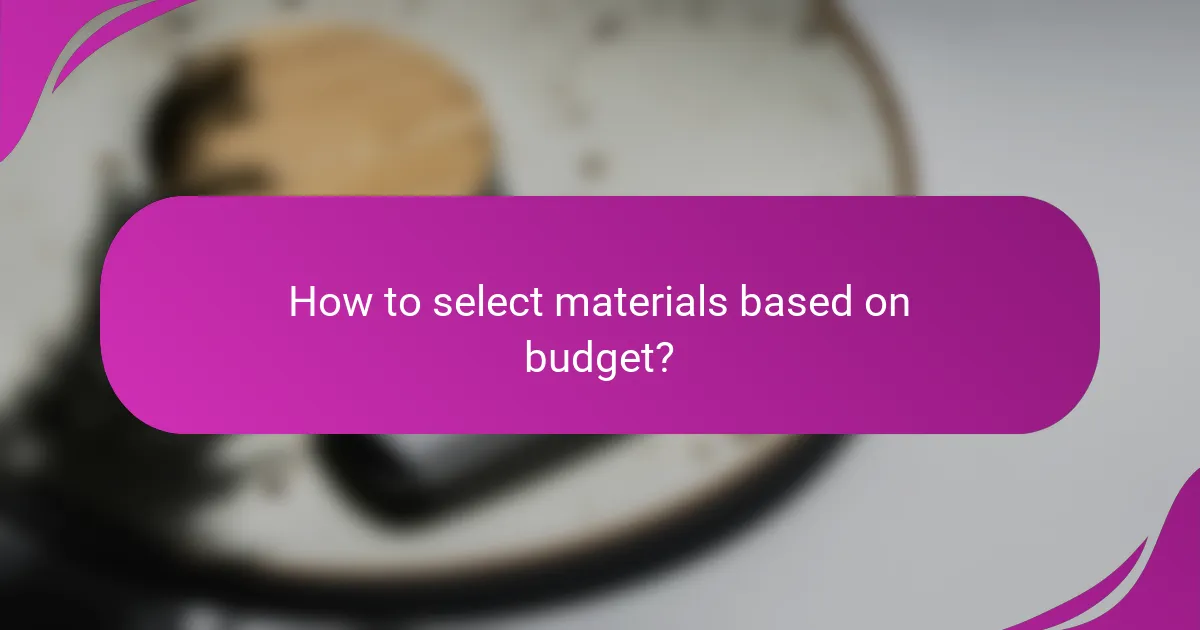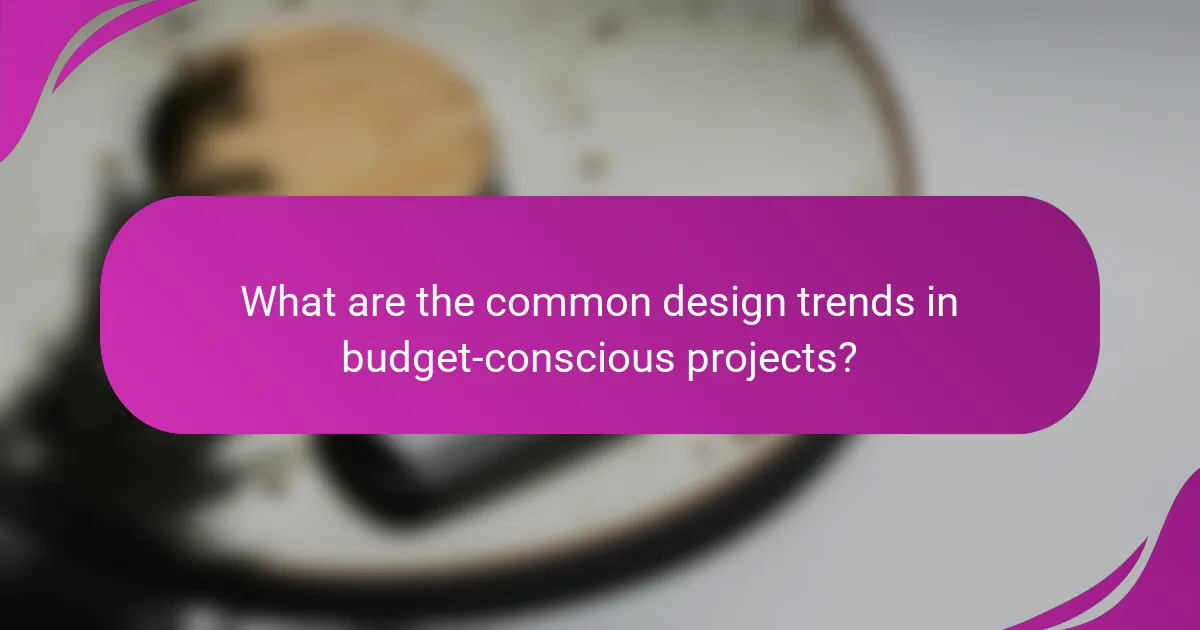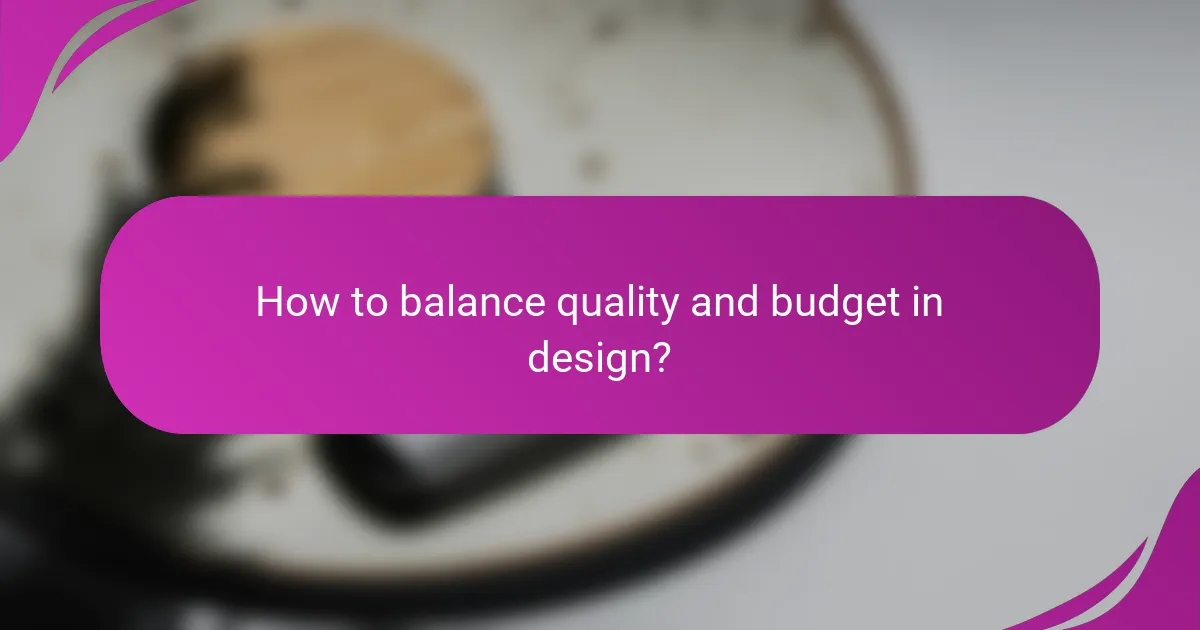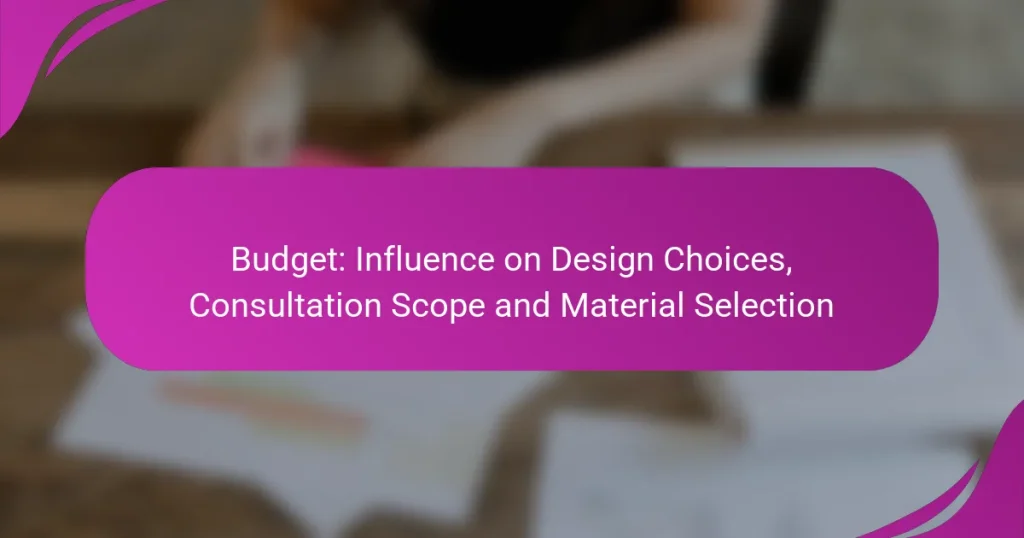In Canadian architecture, budget plays a crucial role in shaping design choices, influencing everything from material selection to project complexity. Architects must navigate financial constraints while striving to create functional and visually appealing structures, ensuring that client expectations align with available resources.

How does budget influence design choices in Canadian architecture?
In Canadian architecture, budget significantly shapes design choices by determining the materials, complexity, and overall scope of a project. Architects must balance aesthetic aspirations with financial constraints to deliver functional and appealing structures.
Material selection based on cost
Material selection is often driven by budget considerations, as different materials come with varying price points. For instance, while high-end finishes like marble or custom woodwork can elevate a design, they may not be feasible for projects with tighter budgets. Instead, architects might opt for cost-effective alternatives such as laminate or engineered wood, which can still achieve a desirable look without overspending.
Additionally, local availability of materials can influence costs. Sourcing materials from nearby suppliers can reduce transportation expenses, making certain options more attractive financially. Architects should always consider both the upfront costs and long-term maintenance expenses when selecting materials.
Design complexity adjustments
Budget constraints often necessitate adjustments in design complexity. More intricate designs typically require additional labor and specialized skills, which can drive up costs. For example, a simple rectangular building will generally be less expensive to construct than a structure with multiple angles and curves.
To manage costs, architects may simplify designs by reducing the number of unique elements or opting for standard sizes and shapes. This approach not only helps in staying within budget but can also streamline the construction process, leading to a more efficient project overall.
Impact on project timelines
Budget influences project timelines as financial limitations can affect the pace of construction. When funds are tight, projects may experience delays due to phased funding or the need to source less expensive materials, which can take longer to procure. This can lead to extended timelines that impact overall project delivery.
Moreover, complex designs that require specialized labor may also result in longer construction periods. To mitigate these issues, it is advisable to establish a clear budget from the outset and maintain open communication with contractors about financial constraints, allowing for better planning and scheduling of the project.

What are the key factors in determining consultation scope?
Determining the consultation scope involves evaluating budget constraints, client expectations, and project requirements. These factors collectively influence the extent of services provided and the overall design approach.
Budget constraints affecting scope
Budget constraints play a crucial role in defining the consultation scope. A limited budget may restrict the range of services offered, necessitating prioritization of essential elements over luxury features. For instance, if a project budget is set at $10,000, it may only allow for basic design consultations rather than extensive revisions or high-end materials.
When assessing budget constraints, consider not only the total project cost but also the allocation for specific phases. It’s wise to set aside a portion of the budget for unexpected expenses, typically around 10-15%, to avoid compromising the project’s quality.
Client expectations and needs
Client expectations and needs significantly shape the consultation scope. Clear communication about what the client envisions can help align the design process with their goals. For example, if a client desires a sustainable design, this may require additional consultations to explore eco-friendly materials and practices.
Understanding the client’s priorities is essential. Conducting a needs assessment can help identify which aspects of the project are non-negotiable and which can be adjusted based on budget limitations. Regular check-ins with the client throughout the process can ensure that their expectations are met without exceeding the budget.

How to select materials based on budget?
Selecting materials based on budget involves evaluating cost-effective options while ensuring quality and durability. Prioritize materials that meet your design needs without exceeding financial constraints, balancing aesthetics and functionality.
Cost-effective material options
When choosing materials, consider alternatives that provide good value without sacrificing quality. For instance, laminate surfaces can be a budget-friendly substitute for hardwood, while vinyl flooring often costs less than tile yet offers similar aesthetics.
Recycled materials, such as reclaimed wood or recycled metal, can also be cost-effective and environmentally friendly. They often come at a lower price point and add unique character to designs.
Durability vs. affordability
Balancing durability and affordability is crucial in material selection. While cheaper materials may save money upfront, they might require more frequent replacements or repairs, leading to higher long-term costs.
Investing in slightly more expensive, durable materials can be wise, especially for high-traffic areas. For example, choosing a quality countertop material like quartz over a less expensive option may ultimately save money due to its longevity and lower maintenance needs.
Local sourcing advantages
Sourcing materials locally can significantly reduce costs and support the local economy. Local suppliers often have lower shipping fees, which can make a substantial difference in overall project expenses.
Additionally, local materials may be better suited to the regional climate and conditions, enhancing durability and performance. For example, using local stone for exterior work can ensure better weather resistance and aesthetic harmony with the surroundings.

What are the common design trends in budget-conscious projects?
Budget-conscious projects often prioritize cost-effective design trends that maximize value while minimizing expenses. Common trends include sustainable practices and minimalist aesthetics, both of which help to create appealing spaces without overspending.
Sustainable design practices
Sustainable design practices focus on using eco-friendly materials and energy-efficient solutions to reduce environmental impact and long-term costs. This can involve selecting locally sourced materials, which not only supports the local economy but also reduces transportation expenses.
Incorporating elements like natural lighting, efficient insulation, and renewable energy sources can lead to significant savings on utility bills. For example, using LED lighting and high-efficiency appliances can cut energy costs by a considerable percentage over time.
Minimalist aesthetics
Minimalist aesthetics emphasize simplicity and functionality, which can significantly lower design and material costs. By reducing the number of elements in a space, projects can focus on high-quality materials and finishes that make a strong impact without clutter.
Choosing a neutral color palette and fewer decorative items can create a clean, modern look while allowing for flexibility in design. This approach not only saves on materials but also simplifies maintenance, making it a practical choice for budget-conscious projects.

How to balance quality and budget in design?
Balancing quality and budget in design requires a strategic approach that prioritizes essential features while considering long-term value. Focus on what is necessary for functionality and aesthetics, and evaluate how choices impact overall costs and durability.
Prioritizing essential features
Identifying essential features is crucial for effective budget management in design. Start by listing the must-have elements that fulfill the project’s core objectives, such as functionality and user experience. For instance, in a residential kitchen remodel, prioritize durable countertops and efficient appliances over decorative elements.
Once you have a list, rank these features based on their importance and impact on the overall design. This helps in making informed decisions about where to allocate funds, ensuring that critical aspects are not compromised for less important details.
Long-term value considerations
When selecting materials and design elements, consider their long-term value rather than just initial costs. Investing in higher-quality materials may lead to lower maintenance costs and longer lifespans, ultimately saving money over time. For example, opting for hardwood flooring instead of laminate may have a higher upfront cost but offers durability and resale value.
Additionally, assess the potential for energy efficiency and sustainability in your choices. Designs that incorporate energy-efficient appliances or sustainable materials may qualify for rebates or lower utility bills, providing further financial benefits in the long run.

What are the impacts of budget on project timelines?
The budget significantly influences project timelines by dictating the scope of work, resource allocation, and material selection. Limited financial resources can lead to extended timelines as teams may need to adjust their plans to accommodate cost constraints.
Extended timelines due to budget cuts
When budget cuts occur, projects often face extended timelines as teams must reassess their strategies. This may involve scaling back on certain aspects of the design or delaying phases of the project until additional funding is secured.
For example, if a construction project has its budget reduced, the contractor may need to extend the timeline to find more affordable materials or labor. This can lead to delays in project completion, impacting overall schedules and potentially increasing costs in the long run.
To mitigate these delays, it is crucial to prioritize essential features and streamline processes. Regularly reviewing the budget and adjusting timelines accordingly can help maintain project momentum despite financial constraints.

